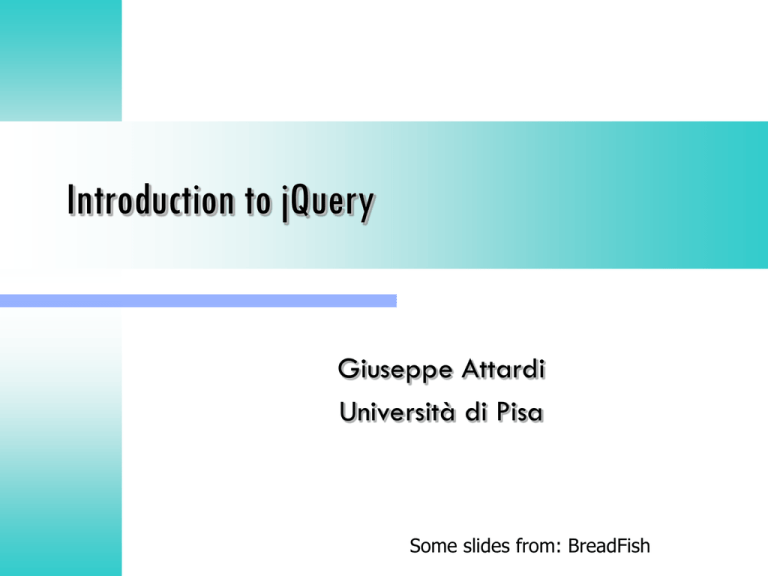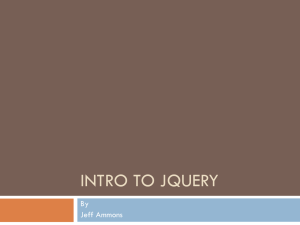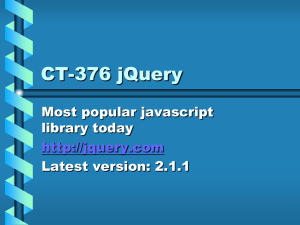jQuery - DidaWiki - Università di Pisa
advertisement

Introduction to jQuery
Giuseppe Attardi
Università di Pisa
Some slides from: BreadFish
JavaScript
A script language that interpreted
by browser
OOP
Dynamic typing
Run-time evaluation
JavaScript
Cannot access host computer (except
cookie)
Same origin policy
Non-persistence
Cannot access history object
Cannot write the value of file upload field
JavaScript Libraries
jQuery
Mootools
Prototype
YUI
Introduction to jQuery
Developed in 2006 by John Resig at Rochester
Institute of Technology
jQuery is a lightweight JavaScript library that
emphasizes interaction between JavaScript and
HTML
jQuery is free, open source software Dual-licensed
under the MIT License and the GNU General Public
License
Helps web developers to create simple pieces of
interaction without being forced to write long,
complex, book-length pieces of code
Introduction to jQuery
Why do I want it
Rich Internet Applications (RIA)
Dynamic HTML (DHTML)
How do I get it
www.jquery.com
How can I learn it
jQuery in Action by Bibeault & Katz, Manning
jQuery Visual Quickstart Guide by Holzner, Peachpit
www.jquery.com
docs.jquery.com
www.visualjquery.com
www.Jqueryfordesigners.com
www.gscottolson.com/weblog/ - cheat sheet
www.javascripttoolbox.com/jquery
Summary
Introduction, installation, “Howdy World”,
Ready function, DOM, Selecting and
Formatting web page elements
Events and Animations
jQuery Plugin libraries
AJAX with PHP and ASP.NET
Introduction to jQuery
Installation
just download the jquery-1.x.x.js file and put it in
your website folder
Using jQuery
Visual Web Developer Express Edition
Expression Web
What jQuery Does
“Unobtrusive” JavaScript
separation of behavior from structure
CSS
separation of style from structure
Allows adding JavaScript to your web pages
Advantages over just JavaScript
Much easier to use
Eliminates cross-browser problems
5 Things jQuery Provides
Select DOM (Document Object Model)
elements on a page – one element or a group
of them
Set properties of DOM elements, in groups
(“Find something, do something with it”)
Creates, deletes, shows, hides DOM
elements
Defines event behavior on a page (click,
mouse movement, dynamic styles,
animations, dynamic content)
AJAX calls
The DOM
Document Object Model
jQuery is “DOM scripting”
Heirarchal structure of a web page
You can add and subtract DOM elements on
the fly
You can change the properties and contents
of DOM elements on the fly
The DOM
“a cross-platform and language-independent convention for representing
and interacting with objects in HTML, XHTML and XML documents.
Aspects of the DOM (such as its "Elements") may be addressed and
manipulated within the syntax of the programming language in use.”
Wikipedia
The jQuery Function
jQuery() = $()
$(function)
The “Ready” handler
$(‘selector’)
Element selector expression
$(element)
Specify element(s) directly
$(‘HTML’)
HTML creation
$.function()
Execute a jQuery function
$.fn.myfunc(){} Create jQuery function
The Ready Function
Set up a basic HTML page and add jQuery
Create a “ready” function
Call a function
5 ways to specify the ready function
jquery(document).ready(function(){…};);
jquery().ready(function(){…};)
jquery(function(){…};)
jquery(dofunc);
$(dofunc);
Selecting Elements
Creating a “wrapped set”
$(selector)
selector:
$(‘#id’)
id of element
$(‘p’)
tag name
$(‘.class’)
CSS class
$(‘p.class’) <p> elements having the CSS class
$(‘p:first’) $(‘p:last’) $(‘p:odd’) $(‘p:even’)
$(‘p:eq(2)’)
gets the 2nd <p> element (1 based)
$(‘p’)[1]
gets the 2nd <p> element (0 based)
$(‘p:nth-child(3))
gets the 3rd <p> element of the parent. n=even, odd too.
$(‘p:nth-child(5n+1)’) gets the 1st element after every 5th one
$(‘p a’)
<a> elements, descended from a <p>
$(‘p>a’)
<a> elements, direct child of a <p>
$(‘p+a’)
<a> elements, directly following a <p>
$(‘p, a’)
<p> and <a> elements
$(‘li:has(ul)’)
<li> elements that have at least one <ul> descendent
$(‘:not(p)’)
all elements but <p> elements
$(‘p:hidden’)
only <p> elements that are hidden
$(‘p:empty’) <p> elements that have no child elements
Selecting Elements, cont.
$(‘img’[alt])
$(‘a’[href^=http://])
$(‘a’[href$=.pdf])
$(‘a’[href*=ntpcug])
<img> elements having an alt attribute
<a> elements with an href attribute
starting with ‘http://’
<a> elements with an href
attribute ending with ‘.pdf’
<a> elements with an href attriute
containing ‘ntpcug’
Useful jQuery Functions
.each()
.size()
.end()
.get(n)
.eq(n)
.slice(n,m)
.not(‘p’)
.add(‘p’)
.remove()
.empty()
.filter(fn/sel)
.find(selector)
.parent()
.children()
.next()
.prev()
.siblings()
iterate over the set
number of elements in set
reverts to the previous set
get just the nth element (0 based)
get just the nth element (0 based) also .lt(n) & .gt(n)
gets only nth to (m-1)th elements
don’t include ‘p’ elements in set
add <p> elements to set
removes all the elements from the page DOM
removes the contents of all the elements
selects elements where the func returns true or sel
selects elements meeting the selector criteria
returns the parent of each element in set
returns all the children of each element in set
gets next element of each element in set
gets previous element of each element in set
gets all the siblings of the current element
Formatting Elements
.css(property, value)
.html()
.val()
(form elements)
.text()
.addClass(‘class’)
.removeClass(‘class’)
Add Page Elements
$(‘#target’).before(‘<p>Inserted before #target</p>’);
$(‘#target’).after(‘<p>This is added after #target</p>’);
$(‘#target’).append(‘<p>Goes inside #target, at end</p>’);
$(‘#target’).wrap(‘<div></div>’);
Adding Events
Mouseover events – bind, hover, toggle
Button click events
Keystrokes
Event Background
DOM Level 2 Event Model
Multiple event handlers, or listeners, can be
established on an element
These handlers cannot be relied upon to run an
any particular order
When triggered, the event propagates from the top
down (capture phase) or bottom up (bubble
phase)
IE doesn’t support the “capture phase”
Basic Syntax of Event Binding
$(‘img’).bind(‘click’,function(event){alert(‘Howdy’;});
$(‘img’).bind(‘click’,imgclick(event));
Allows unbinding the function
$(‘img’).unbind(‘click’,imgclick());
$(‘img’).unbind(‘click’);
$(‘img’).one(‘click’,imgclick(event));
Only works once
$(‘img’).click(imgclick);
$(‘img’).toggle(click1, click2);
$(‘img’).hover(mouseover, mouseout);
Element Properties – “this”
this
this.id
this.tagName
this.attr
this.src
this.classname
this.title
this.alt
this.value (for form elements)
‘Event’ properties
event.target ref to element triggering event
Event.target.id id of element triggering event
event.currentTarget
event.type
type of event triggered
event.data
second parm in the bind() func
Various mouse coordinate properties
Various keystroke related properties
Event Methods
.stopPropagation() no bubbling
.preventDefault()
no <a> link, no <form> submit
.trigger(eventType) does not actually trigger the event,
but calls the appropriate function
specified as the one tied to the
eventType
.click(), blur(), focus(), select(), submit()
With no parameter, invokes the event handlers, like trigger
does, for all the elements in the wrapped set
Shortcut Event Binding
.click(func)
.submit(func)
.dblclick(func)
.mouseover(func)
.mouseout(func)
.select(func)
Useful Event Functions
.hide()
display:true
.show()
display:none
.toggle(func1, func2) first click calls func1, next click
executes func2
.hover(over, out)
mouseover, mouseout
Examples of Events
Toggle.html
Opacity of picture
Hover1.html
Hover using .bind
Events.html
Expanding a DIV
TableStripes.html Table highlighting
Collapsible.list.html
Expandable List
Custom.effects.html
Animations
Other examples
Table stripes
Animations
Expanding Lists
ASP.NET Gridview
Extending jQuery
Creating a jQuery function
jQuery Plugins (UI Library)
Tab example
Slider example
Carousel example
Photomatic example
jQuery Core
jQuery(selector, [ context ]): Accepts a
string containing a CSS selector which is then
used to match a set of elements and returns a
jQuery object.
jQuery(element)
jQuery(elementArray)
jQuery(jQuery object)
jQuery()
can be written as $()
jQuery Events
.ready(handler) : execute handler when the DOM is fully loaded.
js
function printhello(){
$(“#hello”).html(“Hello, jQuery!”);
}
$(document).ready(printhello());
Same as window.onload???
js
$(document).ready(function(){
$(“#hello”).html(“Hello, jQuery!”);
});
jQuery Events
.bind()
.blur()
.change()
.click()
.focus()
.hover()
.select()
.toggle()
.trigger()
.submit()
.mousedown()
.mouseenter()
.mouseleave()
.keypress()
.keyup()
jQuery Events
$(document).keyup(function(event) {
switch(event.which) {
case 32:
alert(“32 pressed”);
break;
}
});
event.preventDefault()
event.stopPropagation()
jQuery Selectors
follows CSS1~3 Selectors
http://www.w3.org/TR/css3-selectors
:animated
:has()
:gt()
jQuery Attributes
.addClass()
.removeClass()
.hasClass()
.toggleClass()
.attr()
.removeattr()
.val()
.html()
jQuery Each
.each() : Iterate over a jQuery object, executing a function for
each matched element.
html
<ul>
<li>garbage</li>
<li>food</li>
<li>abroad</li>
</ul>
js
$(document).ready(function(){
$('li').each(function(index) {
alert(index + ': ' + $(this).text());
});
});
jQuery Traversing
.add()
.children()
.contents()
.filter()
.find()
.next()
.not()
.prev()
jQuery Manipulations
.append()
.appendTo()
.clone()
.detach()
.insertAfter()
.insertBefore()
.remove()
jQuery CSS
.css()
.height()
.width()
.position()
.offset()
.scrollTop()
.scrollLeft()
jQuery Effect
.animate()
html
<button id="left">left</button>
<button id="right">right</button>
<div class="block"></div>
js
$(document).ready(function(){
$(".block").css({
'position': 'absolute',
'backgroundColor': "#abc",
'left': '100px',
'width': '90px',
'height': '90px',
'margin': '5px' });
$("#left").click(function(){
$(".block").animate({left: "-=50px"}, "slow");
});
$("#right").click(function(){
$(".block").animate({left: "+=50px"}, "slow");
});
});
jQuery Effect
.fadeIn()
.hide()
.show()
.toggle()
AJAX
Asynchronous JavaScript And XML
The basic AJAX function – XMLHttpRequest
Initiating a request
Getting the response
jQuery AJAX
jQuery.get(url, [ data ], [ callback(data, textStatus,
XMLHttpRequest) ], [ dataType ])
Returns: XMLHttpRequest
jQuery.post()
jQuery.getJSON()
jQuery.load()
jQuery.getScript()
AJAX Example
Does ‘username’ exist?
yes/no
username
jQuery
HTML
print
server
check…
jQuery AJAX
html
<div id="user_check">
<input id="username" type="text"></input>
<input id="username_submit" type="button"
value="submit"></input>
<p id="check_result"></p>
</div>
js
$(document).ready(function(){
$("#username_submit").click(function(){
$.get('jqtest.cgi', {"username" : $("#username").val()},
function(data){
$('#check_result').html(data);
});
});
});
CGI
#! /usr/bin/python
import cgi
import os
form = cgi.FieldStorage()
print "Content-Type: text/html\n\n“
name = form.getvalue('username', '1')
if os.path.exists("/home/“ + name + "/"):
print "exists"
else:
print "not exists"
JSONP
Avoids limitation of same origin requests
Trick: <script> elements are not constrained
Use <script> to retrieve JavaScript code that
operates on dynamically generated JSONformatted data from other origins
JSONP Mechanism
Suppose a request to
http://server/User?Id=1234
returns
{"Name": “Pippo", "Id" : 1234, "Rank": 7}
Add parameter to request
<script type="text/javascript"
src="http://server/User?UserId=1234&jsonp=p
arseResponse"> </script>
So that the answer becomes:
parseResponse({"Name": "Foo", "Id" : 1234,
"Rank": 7})
JSONP Example
jQuery.getJSON("http://search.twitter.com/search.json?call
back=?",
{ q: "Arsenal“ },
function(tweets) {
// Handle response here
console.info("Twitter returned: ",tweets);
});
CORS
Cross-Origin Resource Sharing
W3C specification
Allows cross-domain communication from the
browser
Uses XMLHttpRequest
Supported by some browsers
CORS Example
// Create the XHR object.
function createCORSRequest(method, url) {
var xhr = new XMLHttpRequest();
if ("withCredentials" in xhr) {
// XHR for Chrome/Safari/Firefox.
xhr.open(method, url, true);
} else if (typeof XDomainRequest != "undefined") {
// XDomainRequest for IE.
xhr = new XDomainRequest();
xhr.open(method, url);
} else // CORS not supported.
xhr = null;
return xhr; }
var xhr = createCORSRequest('GET', url);
if (!xhr) { throw new Error('CORS not supported'); }
xhr.onload = function() {
var responseText = xhr.responseText;
console.log(responseText);
// process the response.
};
xhr.onerror = function() {
console.log('There was an error!');
};
Embedding a Map
<iframe width="425" height="350" frameborder="0"
scrolling="no" marginheight="0" marginwidth="0"
src="http://maps.google.com/maps?f=q&amp;sou
rce=s_q&amp;hl=en&amp;geocode=&amp;q=lar
go+pontecorvo+3,+pisa,+italy&amp;aq=&amp;sll
=37.0625,95.677068&amp;sspn=33.901528,36.474609&a
mp;vpsrc=0&amp;ie=UTF8&amp;hq=&amp;hnea
r=Via+Pellegrino+Pontecorvo,+3,+56121+Pisa,+
Toscana,+Italy&amp;t=m&amp;z=14&amp;ll=43.
682725,10.428894&amp;output=embed">
</iframe>








